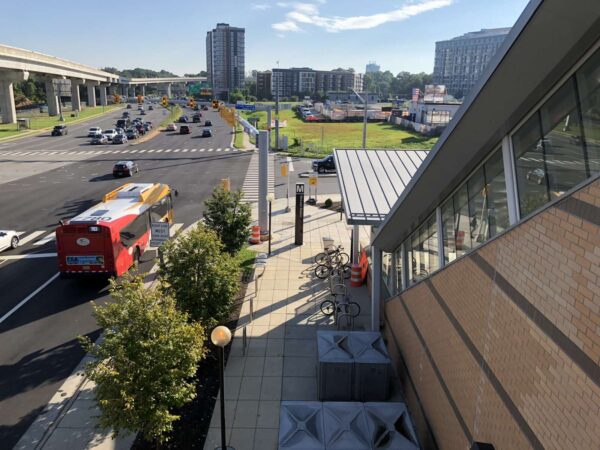
Some transportation projects on the horizon have sparked excitement among the Fairfax County Board of Supervisors over potential transit improvements.
Visualize 2050 is a federally-mandated long-range transportation plan with an emphasis on projects that adhere to new emission reduction goals.
In a meeting of the Board of Supervisors Transportation Committee earlier this month, staff said the county has six projects it’s considering adding to Visualize 2050. The projects have to be considered regionally significant.
- Route 7 Bus Rapid Transit (BRT)
- Orange Line Metrorail Extension
- Yellow Line Metrorail Extension to Hybla Valley
- I-495 Southside Project
- I-95 Counterflow Express Lanes
- Seven Corners
Providence District Supervisor Dalia Palchik said the inclusion of Route 7 BRT is a positive step, helping take the project from the conceptual stage to something being actively planned.
“I think it’s really exciting that we’re considering this and I would support BRT 7, “Palchik said. “It brings dedicated bus lanes. We’re talking about reducing congestion and using these roads to more easily have multimodal. I think it’s not super helpful when buses get stuck in traffic for people to give up their cars and opt for the bus.”
The Route 7 BRT proposal would eventually connect Tysons to Alexandria on a new route designed to prioritize public transit. Mason District Supervisor Penny Gross said she’s hopeful districts between the two major stops will also benefit.
“Certainly Route 7 BRT will go all along Route 7, coming from Alexandria [in one direction] and Tysons [from the other],” Gross said. “I’m hoping that [Mason District] can be the golden spike.”
Elsewhere in county planning, Franconia District Supervisor Rodney Lusk advocated for Metro’s Yellow Line extension down into Hybla Valley.
“That’s in alignment with what we’re doing with bus rapid transit and our Embark Richmond Highway study,” Lusk said. “The goal is that we eventually get to the extension of that Metro line. I just want to advocate for that and put a plug so that it can be considered.”
County staff said there will be two public meetings on the Visualize 2050 plan in April before the project works its way through the bureaucratic process, eventually heading to plan adoption sometime in December 2024.
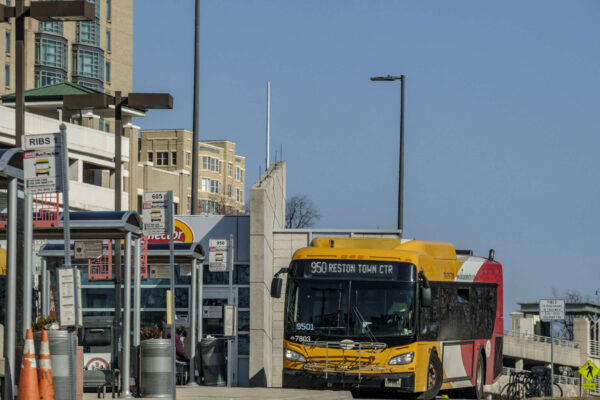
Fairfax Connector could be free for all children ages 12 and under.
The Fairfax County Department of Transportation’s current policy is kids under 5 years old do not need to pay a fare. The new policy would extend that to all children under 12.
Older children can already get a free student bus pass: all Fairfax County middle and high school students can ride on all Fairfax County routes and some Metrobus routes for free between 5 a.m.-10 p.m. with a student bus pass. The transportation department said in a presentation the change would “close a gap” in the county’s fare-free policy for kids.
Those children would still obviously need to be accompanied by a fare-paying adult to receive a free fare.
In a presentation, the Department of Transportation said there are several potential benefits to the change.
- Closes the gap in fare-free travel for children between ages 5-12
- Increases accessibility and removes barriers to travel for parents. Especially beneficial for trips to access medical or social services
- This change will help children become acclimated to using public transit from an early age thereby creating increased transportation alternatives
FCDOT is collecting feedback on the proposed change until next Friday, March 10.
The policy change is scheduled to be presented to the Fairfax County Board of Supervisors on April 11. If approved, it would take effect on April 30.
Fairfax Connector launched a pilot last month allowing low-income riders to get half-price fares.
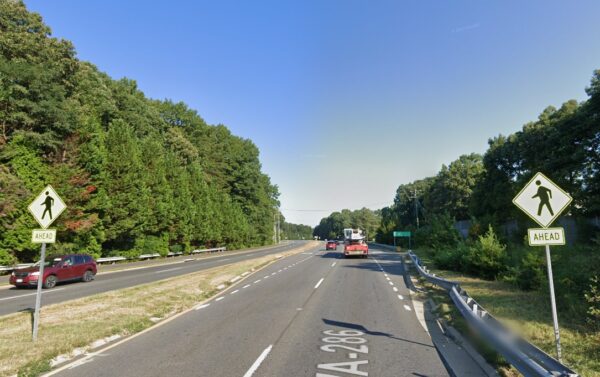
Fairfax County Parkway is one of the main arterial routes through western Fairfax County, but staff say it’s due for an overhaul.
At a recent meeting of the Fairfax County Planning Commission’s Transportation Committee, Department of Transportation senior planner Thomas Burke laid out some of the changes recommended in a recent study of the Fairfax County and Franconia-Springfield parkways.
The study looked at 35 miles of the corridor broken up into five segments. Notably, it evaluated transit and multi-modal transportation along the parkways, rather than just vehicle traffic.
On the multi-modal front, Burke said one key takeaway was that the current bicycle and pedestrian facilities were inadequate.
“There was a lot of support in the community for enhancing bicycle and pedestrian experience on the parkways,” Burke said. “Right now, there’s one trail on one side of the parkway and a few gaps.”
Burke said the first priority should be plugging those gaps to have one contiguous trail running from Reston to Fort Belvoir.
“We took it another step based on community feedback,” Burke said. “Why don’t we put a trail on the other side so you don’t have to cross a six-lane highway to get to the shared use path, especially if you don’t need to cross it because origin and destination are on the same side?”
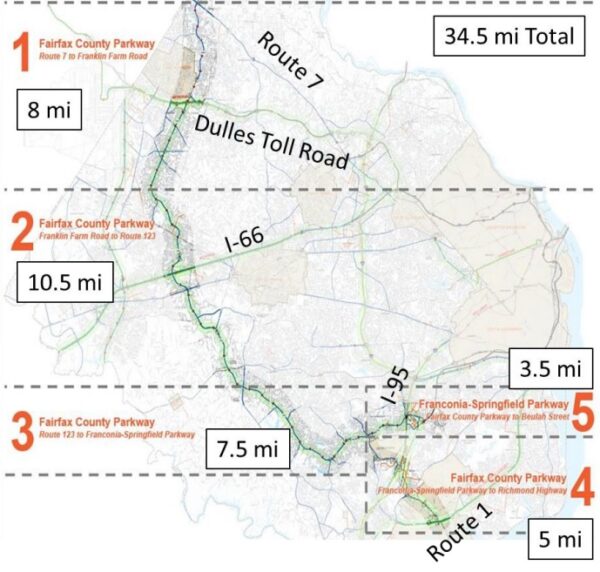
On the other hand, Burke said there isn’t enough demand for transit along the parkway for that to make sense as an emphasis for any sort of parkway overhaul.
“We took a transit look as well: transit is an interesting challenge for the parkways because there’s not a lot of density or employment centers,” Burke said. “There’s a lot of low-density areas and not a whole lot of jobs.”
Burke said the study similarly didn’t find as much demand for the high-occupancy vehicle options seen on other roadways around Fairfax County.
“For decades we’ve had HOV recommendations for most of the parkways,” Burke said. “From Franconia-Springfield — where the Metro is — up to Route 7, all has little diamonds signifying there will eventually be HOV…But we did not find a lot of demand.”
Burke said the study considered both 2+ and 3+ HOV lanes, but found low demand for either option.
The study also looked at road widening, with earlier staff recommendations saying parts of the parkway should be increased to eight lanes. But for the most part, Burke said the study found six lanes was sufficient for the northernmost sections of Fairfax County Parkway.
At the southernmost point of the study, where the Franconia-Springfield Parkway connects to Richmond Highway, Burke said the study recommended increasing the roadway to six travel lanes in parts. Just north of that section, where Fairfax County Parkway connects to Beulah Street, Burke said current plans to increase the parkway to eight lanes overshot the mark, and the road only needs its current six lanes.
Burke noted that this study is looking at long-range transportation improvements. Any of those changes, particularly the widening, could take 10-30 years to implement.
In parts, Burke said there was some community resistance to widening the parkways, and before Fairfax County goes forward with widening in those sections, there should be additional research and analysis.
A pair of virtual meetings to discuss the changes are planned for Wednesday, March 1 at noon and Thursday, March 2 at 6:30 p.m.
Image via Google Maps
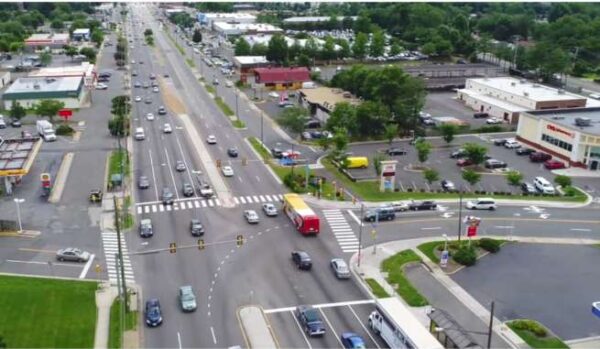
The clock is ticking for Fairfax County and the D.C. region to adopt a new transportation plan aimed at reducing greenhouse gas emissions.
This past June, the National Capital Region Transportation Planning Board (TPB) approved Visualize 2045 — a regional transportation plan that runs through 2045 and must be updated every four years, as mandated by the federal government.
At the same meeting, it voted to include greenhouse gas emission goals in the next plan, targeting cuts of 50% by 2030 and 80% by 2050.
Now, six months later, Fairfax County is already preparing to submit its segment of that plan with those emission goals in mind, but the process will be slightly different from previous years.
Presented at the Board of Supervisors transportation committee meeting on Tuesday (Jan. 31), Visualize 2050 will include “zero-based budgeting,” meaning all localities have to resubmit their transportation projects for consideration to ensure they adhere to the new emission reduction goals.
Before, most projects automatically carried over from one plan to the next, though projects could be added or taken out if needed, Fairfax County Department of Transportation planner Malcolm Watson explained to the supervisors.
Hunter Mill District Supervisor Walter Alcorn, who’s on the TPB with Braddock District Supervisor James Walkinshaw, noted that the board has had a “lively discussion” over the last few years regarding the emission goals.
“There’s been…quite a difference of opinion on the climate change stuff, particularly between the inner jurisdictions and the outer jurisdictions,” Alcorn said. “We are kind of right in between.”
County staff have identified 33 projects they expect to be part of the transportation plan and will need to be resubmitted under the new standards. Projects currently “in development” include Reston Parkway improvements, a new Dulles Airport Access road from Chain Bridge Road, and a widening of Frying Pan Road from Sully to Centreville roads.
Most of those projects are expected to be completed between 2025 and 2040.
There are 25 projects that could be exempted from the emission standards because they are already funded or under construction. Those include the Richmond Highway Bus Rapid Transit system, an I-495 overpass at Tysons Corner Center, and the $237 million Soapstone Connector.
Watson cautioned that the lists may change as projects get taken off and added, depending on priorities, the new emission goals, and other factors.
Next month, the TPB will issue a “call for projects,” and the lists will be officially published for public review.
“This will officially kick off Visualize 2050,” Watson said.
The county board ultimately will have to vote to approve the project lists over the summer before they get submitted to the TPB.
The hope is that by December 2024, the TPB will approve Visualize 2050, and the new emission goals will become the norm, making Visualize 2055 perhaps a bit less labor-intensive.
Photo via Fairfax County
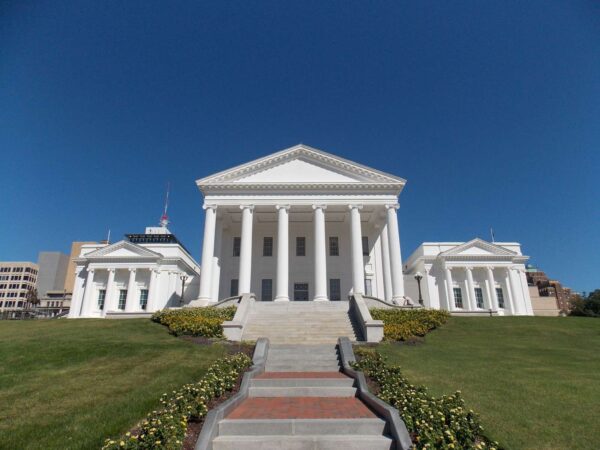
As the Virginia General Assembly convenes this week for its 2023 session, local lawmakers hope to pass bills highlighting campaign finance reforms, raising teacher pay, paid sick leave, and other issues.
The General Assembly will meet in Richmond on Wednesday (Jan. 11) for a 46-day session lasting until Feb. 25, though special and reconvened sessions later in the year are possible.
Members have been allowed to pre-file bills since November, and Fairfax County’s delegation held a public hearing on Saturday (Jan. 7) where community members shared their thoughts on what should be prioritized.
Members have until Wednesday morning to pre-file bills.
Facing a divided General Assembly, with Republicans controlling the House of Delegates and Democrats holding the Senate, local representatives likely won’t see all of their bills become law, but here are 12 proposals worth noting:
Campaign finance reform
- Limit political donations to $20,000: Introduced by Sen. Chap Petersen (D-34), SB 803 would prohibit individuals from making a single donation to anyone vying for state office for more than $20,000.
- Prohibit contributions from public utilities: Also filed by Petersen, SB 804 would prohibit candidates from accepting contributions from any public utility company. Petersen has introduced versions of this bill before but hasn’t succeeded in getting it passed.
- Prohibit personal use of campaign funds: The potential new law HB 1552, introduced by Del. Marcus Simon (D-53), would ban candidates from using campaign funds for personal use, something that’s already prohibited in many other states.
Education
- Alternative learning assessments in schools: SB 819, pre-filed by Sen. Barbara Favola (D-31), aims to allow each local school district “to use any nationally recognized, research-based assessment or screener” as an alternative to Virginia Department of Education-approved tests. This comes after new state-proposed history standards were rejected by the Board of Education in November. Revised draft standards were released Friday (Jan. 6).
- Higher teacher compensation: Del. Kaye Kory (D-38) is co-introducing HB 1497, which calls for state funding to be used to compensate public school teachers at or above the national average. Currently, the average pay for teachers in Virginia is about $7,000 below the national average.
Gun Control
- Unattended firearms in motor vehicles: SB 901, introduced by Sen. Dave Marsden (D-37), would make it illegal to leave a firearm unattended in a motor vehicle unless it’s locked up in its own compartment or container.
Health care
- Prohibit warrants for menstrual health data: SB 852 would prohibit the issuing of warrants for the search and seizure of any device containing digital information related to menstrual health data. Filed by Favola, the bill addresses fears from some that period-tracking apps could be used against someone considering an abortion.
- Paid sick leave for health care and grocery store workers: Introduced by Sen. Scott Surovell (D-36), SB 886 would require health care and grocery store employers to provide paid sick leave. As noted in the bill, current law only requires paid sick leave for some home health care workers. A version of this bill passed the Senate last year but failed in the House.
- Treatment for “problem gambling“: With sports gambling now legal in Virginia, Del. Paul Krizek (D-44) is proposing HB 1465, which would establish a committee to help “reduce the negative effects of problem gambling.”
Rights
- Bars insurrectionists from holding public official: Del. Dan Helmer (D-40) is introducing HB 1562 to bar those “convicted of participating in an insurrection” from ever holding a position of “public trust.”
- ASL interpreters in courtrooms: Surovell’s SB 814 lets the court appoint a certified American Sign Language interpreter itself for the courtroom.
- No arrest for assault on law enforcement in mental health emergency: HB 1561 from Del. Vivian Watts (D-39) exempts individuals from being arrested or prosecuted for assaulting a law enforcement officer if they’re experiencing a mental health emergency. A study done last year showed that about 10% of those charged with assault on law enforcement officers had a history of mental illness.
Transportation
- Pedestrian signals apply to bicycles and scooters: Favola’s SB 847 calls for pedestrian control signals to also apply to those riding bicycles, mopeds, electric bikes, scooters, and all other forms of electric motor transportation. A companion bill is being filed by Del. Rip Sullivan (D-48) in the House.
Photo via Doug Kerr/Flickr

Empower founder and CEO Joshua Sear is the kind of ride-share passenger who likes to talk to his drivers.
It was through those casual conversations that he came up with an idea in 2018 for an app that would offer a viable alternative to the country’s top ride-hailing services — Uber and Lyft — by letting drivers keep all the money they make in exchange for a subscription fee.
“Consistently, they were saying how they weren’t able to make a living, particularly full-time or near full-time drivers, and then, also…they felt voiceless, like they weren’t heard, that they didn’t feel like they were a customer,” Sear told FFXnow in a recent interview. “…The rider is the customer for Uber and Lyft, and the more I thought about, I started to wonder, ‘Well, what would it look like if drivers were customers?'”
Since launching service in the D.C. region two years ago, the McLean-based startup has supported over 2.5 million rides given by about 10,000 drivers, who have collectively earned more than $40 million, Sear says.
Once touted as better-paying options than taxis, both Uber and Lyft have been dogged by questions about driver pay for years, even after the former paid $20 million to settle federal claims that it was misleading drivers in 2017.
Reports indicate that drivers only receive about half of what riders pay and that the companies take a bigger chunk of fares than the 20 to 25% advertised, discrepancies that have persisted despite soaring prices and led drivers in Denver to strike last month.
Where those ride-sharing companies take a portion of each fare, which is calculated based on trip length and duration, demand and other factors, Empower charges drivers a flat subscription rate for use of its app and other services, including customer support for both driver and rider complaints, according to Sear.
Though the company provides recommended rates, drivers set their own fares and keep everything that riders pay, an approach that Sear says has proven appealing to both parties.
“We do a lot of surveys and get feedback from both riders and drivers, and our surveys as to why do you use Empower for riders, the second most prevalent answer is because drivers get 100% of the fare,” Sear said, adding that the top answer is that the rides are generally less expensive.
He says Empower also aims to provide more transparency to drivers, who can see pick-up and drop-off locations and the rate for each ride before they choose to accept it, and more options for riders, who can “favorite” drivers and limit matches to drivers of the same gender. Read More

Fairfax County is seeking more state support for education, a return of $39 million for regional transportation projects and more in its recently approved legislative priorities for next year.
At a meeting last week, the Board of Supervisors approved the adoption of the county’s 2023 legislative programs for both state and federal lawmakers. It passed by a 9-1 vote with only Springfield District Supervisor Pat Herrity opposing.
The approval on Dec. 6 was, more or less, a formality with most of the discussion and debate happening in legislative committee meetings throughout the fall.
In addition to trash collection changes, here are a few of the most notable priorities in this year’s agenda:
Increase state support for education
Jointly with Fairfax County Public Schools, the county wants the state to better address the differences between “high cost-of-living jurisdictions like Fairfax County” and other Virginia localities when funding public education.
State education funding is based on complex formulas and varies from year to year. The county has long argued that the formulas don’t adequately account for its higher cost of living compared to other areas.
“Public education funding in the Commonwealth is enshrined in the Virginia Constitution as a joint responsibility of both state and local governments, so it is essential that the state fully and appropriately meet its Constitutional responsibility to adequately fund K-12 education,” the state legislative program says.
Also, both boards oppose “budget cuts that disproportionately target or affect Northern Virginia” and “policies which divert K-12 education funding away from local public schools and toward non-public options.”
Allow traffic safety measures
Local elected county officials have maintained their call for more local authority from Virginia, where localities only have the powers explicitly granted them by the state.
As crash fatalities mount, the county is advocating for General Assembly legislation that lets localities create and post signage requiring motorists to stop for pedestrians in crosswalks.
Legislation is also needed to clarify that counties can reduce speed limits below 25 miles per hour on state-maintained roads that lie in residential districts, according to the program. Without that authority, the county’s options for addressing speeding are limited.
Restore regional transportation project funding
The state diverted $102 million away from the Northern Virginia Transportation Authority (NVTA) in 2018 to the Washington Metropolitan Area Transit Authority (WMATA) to cover Virginia’s share of Metro funding.
In the several years since, $63.5 million has been restored, but the NVTA is still looking for the remaining nearly $39 million to support road repairs, facility maintenance, and other transportation projects in Northern Virginia.
“This [money] will ensure that transportation projects continue to advance in Northern Virginia after decades of state underfunding,” Braddock District Supervisor James Walkinshaw, who chairs the board’s legislative committee, said in his motion at the Dec. 6 meeting. Read More
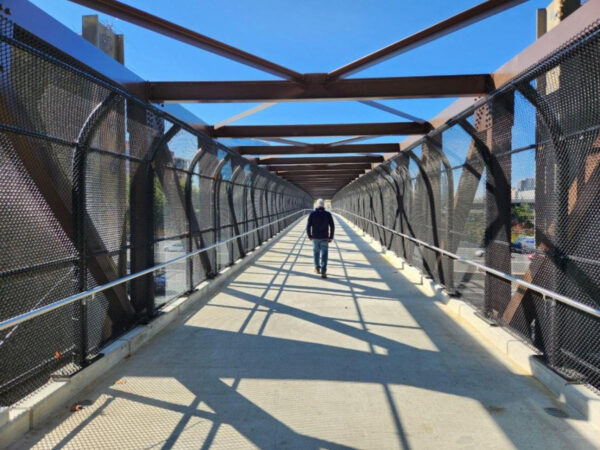
A new bridge for cyclists and pedestrians is connecting two parts of Tysons previously separated by the Beltway.
The new bridge helps provide a link between the residential communities east of the Beltway to the Tysons Corner Center mall.
“The new bicycle and pedestrian bridge over I-495 (Capital Beltway) between Route 7 (Leesburg Pike) and Route 123 (Chain Bridge Road/Dolley Madison Boulevard) opened this afternoon,” the Virginia Department of Transportation (VDOT) said in a release, “greatly improving bicyclist and pedestrian accessibility, connectivity, and safety in the Tysons area.”
Construction started in August 2021 and was supposed to be finished this summer, but VDOT officials previously said the weather was uncooperative.
“Construction on the first phase of the Tysons/Old Meadow Road Bike/Ped Improvements project began in August 2021 and is now substantially complete, with minor work occurring in the coming weeks until final completion with minimal impacts,” the release said. “The project’s second phase will extend the new shared-use path by half a mile along Old Meadow Road from Provincial Drive to Route 123; final design and construction will occur on the second phase as additional funding becomes available.”
The bridge and related improvements cost $13.4 million, paid for with a mix of federal, state and Fairfax County funding.
The trail has already seem some use from enthusiastic locals. Timothy Barrett, President of the McLean Hills Condominium Board of Directors, emailed FFXnow to share some of the excitement from the neighborhood.
“Yesterday, I took a walk with my dog, Bobby, across the new pedestrian bridge,” Barrett wrote. “I’m president of the McLean Hills Condominium Board of Directors, and we are delighted to have immediate access to Tysons now without crossing any streets! Bobby Barrett was most excited, enjoying a puppuccino at Starbucks on the Plaza, previously out of reach for his little legs!”

Let there be light…
On (and leading up to) our new bike/ped bridge over the Beltway in Tysons! pic.twitter.com/SDdXmqPmTT
— VDOT Northern VA (@VaDOTNOVA) October 22, 2022
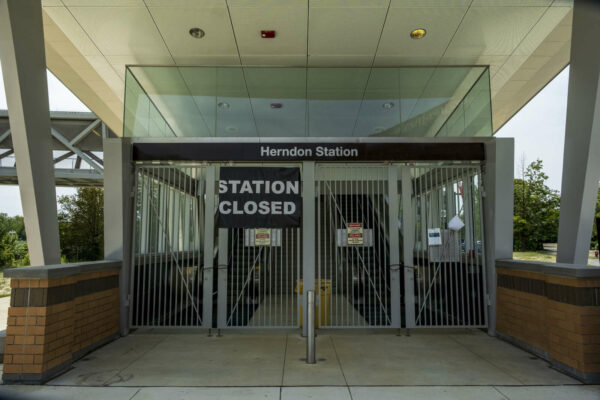
With the Silver Line Phase II opening still in flux, Fairfax County is being asked to pay another $40 million.
At its transportation committee meeting on Friday (Sept. 30), the Board of Supervisors got an update on the ramifications of the Metropolitan Washington Airports Authority (MWAA) agreeing in July to increase the budget for the Silver Line extension by $250 million.
The original project agreement calls for Fairfax County to pay about 16% of the asked-for overage, so with the quarter of a billion dollar budget increase, the county owes an additional $40.25 million.
All told, the county will have spent nearly a billion dollars — $960 million — on the second phase of the Silver Line, which will add six stations from Reston to Ashburn in Loudoun County.
In total, the project has cost just over $3 billion. The board is set to vote on the payment later this month.
While likely to approve the additional payment, several supervisors expressed frustration and annoyance with the need to throw even more dollars at a project that has been besieged by constant delays.
“I don’t think it’s a shock and it’s a tiny portion of the overall project,” Chairman Jeff McKay said. “But [the extra $40 million] has rightly angered a lot of folks given all the delays.”
Dranesville District Supervisor John Foust also made clear he was not happy that the county is being asked to pay more.
“Have we asked ourselves if this is a good deal and the Airports Authority is not just…spending a lot of money to make a problem go away? And it’s our money that they are spending,” Foust asked staff.
He also asked if $960 million will be the final amount. However, county staff couldn’t guarantee that there won’t be any further costs, considering Phase 1 is still undergoing repairs after opening in 2014.
“We still have to reconcile Phase 1 and Phase 2…All parties have to be reconciled at the end of the project,” said Martha Elena Coello, head of special projects for the Fairfax County Department of Transporation. “We are still doing some work on Phase 1 and that needs to be completed. At the end, there will be a reconciliation of both those phases.”
McKay asked, seemingly rhetorically, what would happen if the county didn’t pay the extra money. Staff responded that it might become a “legal matter” since the payment is required by the signed project agreement.
“According to the funding agreement, this is not a ‘might be’ or ‘may be,'” he said. “It’s a requirement for the county. We don’t have the flexibility…without significant negative consequences.”
Still relatively new Metro General Manager Randy Clarke was given authority by the Board of Directors last month to set an opening date for the Silver Line extension. While no exact date has been announced, Clarke said safety certifications are expected this October, and Metro has updated its maps to feature the new stations.
At the same time, Clarke warned that opening the Silver Line could force service reductions due to a deficit in trains when currently shuttered Blue and Yellow Line stations south of Washington National Airport reopen.
That headache will be put off a little longer by an entirely different Metro problem. Last week, the transit agency announced that its new Potomac Yard station won’t open until 2023. As a result, the Yellow and Blue stations will be closed for another two weeks, until Nov. 5.
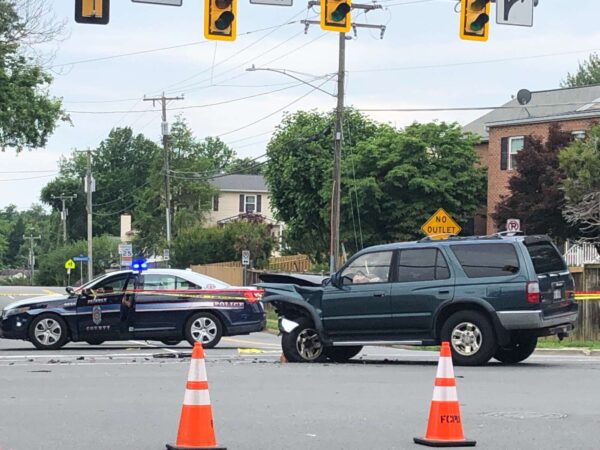
Fairfax County is looking into purchasing additional “Know Your Speed” signs after a fatal crash that killed two Oakton High School students, and seriously injured a third.
After the Oakton crash in early June, the devices were placed on Blake Lane, where the teenagers were walking on the sidewalk before they were struck by a speeding car. Police say the driver, an 18-year-old who has been charged with involuntary manslaughter, was going around 81 mph where the speed limit was 35 mph.
“These signs, that are currently limited in supply and moved to different locations across the county, were deployed to Blake Lane immediately following the crash, and were very much appreciated by the community,” Providence District Supervisor Dalia Palchik said on Tuesday (July 19). “They have now been, understandably, rotated to another site. With a larger inventory of these devices, we could serve more communities for longer periods of time, but I am interested in the staff assessment of this idea.”
The Board of Supervisors directed staff to provide information and recommendations on purchasing more of the devices, which can take the form of signs on mobile trailers or fixed to posts as well as radar guns.
Dranesville District Supervisor John Foust said police have told him no one is available to place the speed devices in his district. The Fairfax County Police Department used to have three people who were properly trained to place them, but two left and one was assigned to a different squad, he said.
“I think we can add all the devices we want, but if we can’t get them in place…Part of this I would hope is that the police will come back and tell us how they’re going to take the devices we have and get them out into the field,” Foust said. “And I ask that it not be relying on district by district. I mean, it’s a countywide problem.”
There are different kinds of devices, and some don’t require a special certification to utilize the devices, Palchik said.
With the FCPD experiencing staffing challenges, Springfield District Supervisor Pat Herrity wondered if civilians could be trained to set up the devices.
“One of the things we might be able to look at as a solution is do we really need police officers to set these up, or can we get other folks trained to set it up? I don’t know whether that’s an option,” he said. Read More

